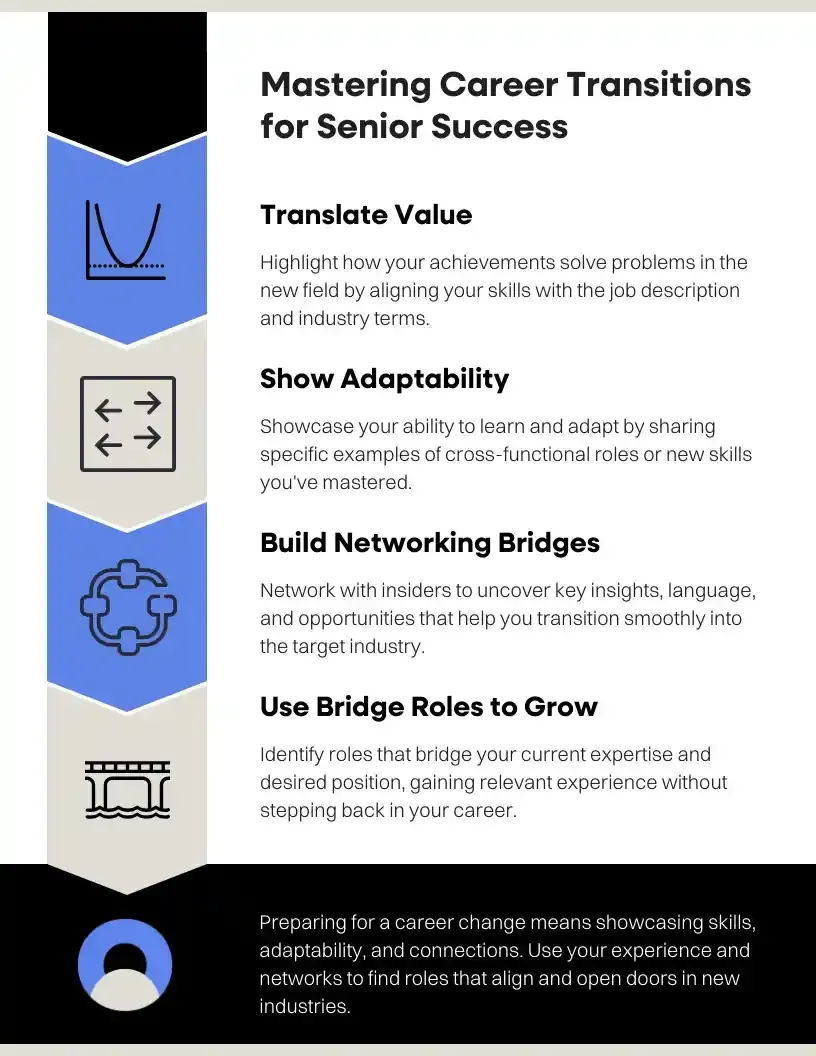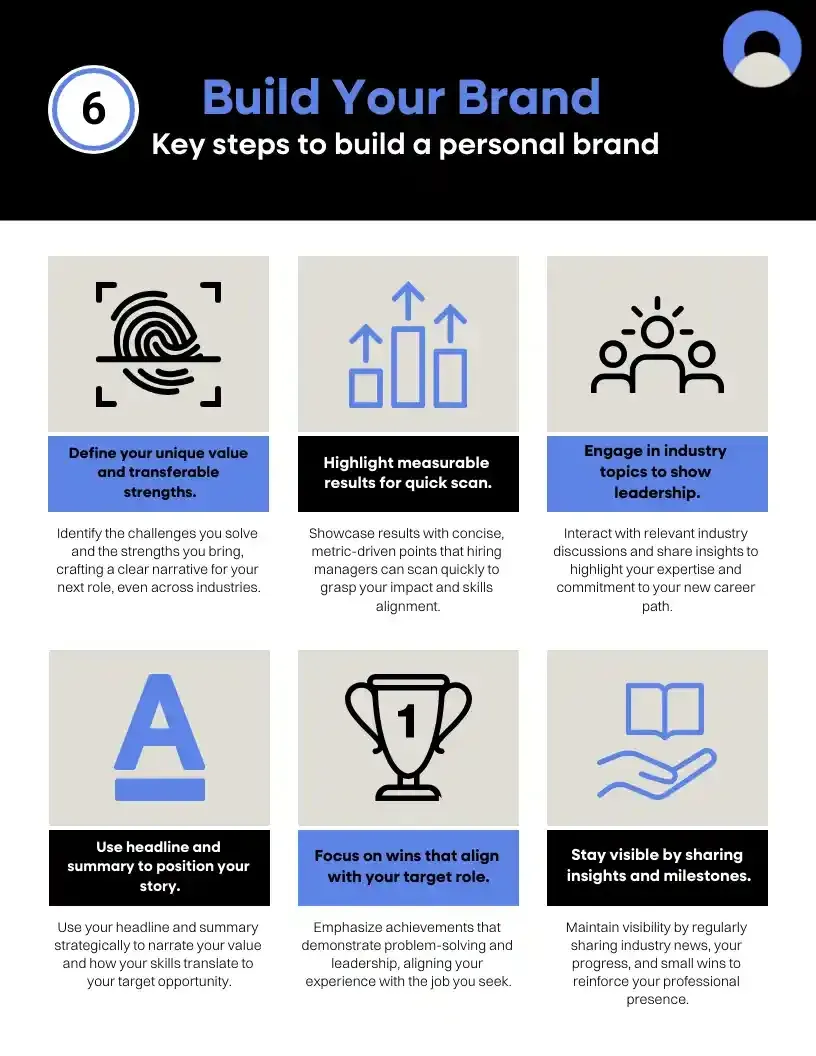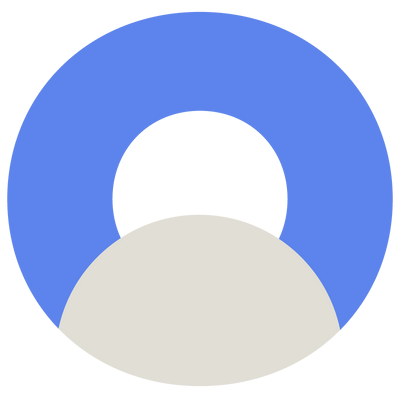How to Switch Industries During a Tough Job Market and Still Win
TL;DR
- Job market still in flux: Some industries (AI, healthcare, clean energy) are growing; others are tightening.
- You’re not alone: 29% of professionals plan to switch jobs in 2025 (Robert Half).
- Key to success? Strategy over spray-and-pray.
4 Steps That Work:
- Translate your value: Match your transferable skills to the job description.
- Prove adaptability: Show how you’ve learned new skills, tools, or roles.
- Build relationships: Informational interviews often lead to referrals.
- Target bridge roles: Find roles that connect your current experience to your new industry.
Bonus Tips:
- Optimize your LinkedIn profile and cover letter for relevance.
- Stay flexible, momentum matters more than perfection.
- Use career coaches, AI tools, and training programs to stay competitive.
You’re not starting over. You’re repositioning. Let’s make your next move count.
The Reality of Switching Industries in a Tough Job Market
Let’s be honest, changing careers is already challenging. But trying to switch industries during a tough job market? That’s a different level of complexity.
Today’s labor market is unpredictable. Tech layoffs, hiring freezes, and tighter budgets have made it harder for job seekers to get noticed. Still, many professionals are choosing to pivot. According to a survey by Robert Half, 29% of professionals expect to search for a new role in 2025.
That stat tells us two things:
- You’re not alone.
- Switching industries is possible, even now.
I’ve done it myself. In 2020, I transitioned from Boeing to Amazon. I left Production Engineering behind to move into Program Management, during a turbulent market. The key? I didn’t just apply to new roles randomly. I translated my value, found a “bridge role,” and positioned myself accordingly.
Let me walk you through how to switch industries during a tough job market and still win, step by step.
2. Show Proof of Adaptability
When you're changing careers, your track record of adaptability is a core asset.
Have you worked across functions? Stepped into stretch roles? Completed training programs or picked up new skills like AI tools, data visualization, or process automation?
Those are worth highlighting. Use specific examples.
- “Led a cross-functional team to implement an AI agent for the company's ecommerce website, reducing abandoned carts by 21% and increasing ecommerce revenue by 9%.”
- “Self-taught Power BI to create dashboards that improved reporting accuracy by 25%.”
Hiring in a new industry means convincing people you can thrive outside of your comfort zone. Show them you're already doing that.

3. Bridge with Relationships
Informational interviews are gold when making career transitions.
Here’s what I tell every client: If you're trying to switch industries, you can’t rely on online job boards alone. Network with professionals already in your target field. Ask how they got in, what challenges they faced, and what skills their team values most.
These conversations often reveal:
- What mistakes to avoid.
- What language to use in your applications.
- Which companies are most open to cross-industry candidates.
And sometimes, those same people become your internal referrals. Win-win.
4. Target “Bridge Roles”
Not every job is the job.
Sometimes, the smartest move is to find a bridge role, one that exists between your current skill set and the target role you eventually want.
That’s exactly what I did moving from Boeing to Amazon. I used Program Management as a way to reposition myself, bridging my engineering background with my desire to lead business operations.
Look for roles that:
- Exist in your target industry.
- Require transferable skills you already have.
- Offer exposure to the right teams, tools, or problems.
This way, you gain industry-specific experience without taking a massive step backward.

The Mindset Shift: Adaptability Over Perfection
Here’s something career coaches don’t talk about enough: you have to stay flexible; especially in a tight job market.
The path to your new career may not follow a straight line. Your next role might not check every box or carry your ideal title. That’s okay. When you're trying to switch industries during an uncertain economy, the goal is momentum, not perfection. Forward motion > stagnation.
Stay open. Keep moving forward. Let the process evolve.
Be prepared to:
- Take small wins and build on them
→ Land an interview in a different field? Great. Get feedback? Even better. Each step forward creates traction. - Adapt your pitch based on feedback
→ Listen to what hiring managers and your network are telling you. What resonates? What’s missing? Use this input to strengthen your resume, cover letter, and LinkedIn profile. - Experiment, learn, and recalibrate your strategy
→ Don’t be afraid to test new formats, explore bridge roles, or adjust your job hunting approach. Every iteration brings you closer to your next role.
Changing careers isn’t starting over, it’s building on everything you’ve already accomplished. You're not erasing your past. You're reframing it for a new industry, using your transferable skills and experience to lead your career change journey.
Building a Strong Personal Brand to Support Your Transition
Every job seeker needs a compelling story, and your LinkedIn profile is where it starts.
In today’s labor market, hiring managers often look at your LinkedIn before your resume. It's more than a digital resume; it's your professional brand.
Here’s how to make it work for your career change journey:
Clarify Your Value Proposition
→ What problems do you solve?
→ What strengths do you bring that transfer across industries?
→ Position yourself clearly for the next opportunity, even if it's in a different field.
Tip: Use your headline and summary to tell your story. Show how your transferable skills and achievements make you a strong fit for your new career path.
Make it Skimmable and Metrics-Driven
→
Focus on outcomes and measurable accomplishments.
→ Use bullet points, white space, and formatting for easy scanning.
→ Align your experience with relevant skills listed in your target job description.
Tip: Hiring managers are busy. Highlight wins that show how you solve problems and lead results, not just tasks.
Engage With the Community to Show Thought Leadership
→ Comment on news or trends in your target industry.
→ Share content that reflects your own journey or industry insights.
→ Celebrate small wins and milestones in your job hunting process.

Tip: Consistent engagement helps you stay visible and shows employers you're serious about moving forward.
A strong LinkedIn profile doesn't just help you get noticed, it helps you get remembered. In a competitive job market, that can make all the difference.
Career Support: Use Every Tool Available
You don’t have to do this alone. If you’re navigating a career change or trying to switch industries during a tough job market, tapping into the right support can make the process faster, smoother, and more strategic.
Here’s what to leverage:

Career Coaches
→
Help you clarify your goals and position your background.
→ Create a clear action plan with milestones and accountability.
→ Build confidence and stay focused during the job hunting process.
Many professionals find that working with career coaches helps them communicate their transferable skills more effectively and move through the interview process with greater clarity.
AI Tools for Job Seekers
→
Use Rezi or Jobscan to tailor your resume and cover letter to the exact job description.
→ Tools like ChatGPT can assist with brainstorming bullet points, optimizing your LinkedIn profile, or preparing for interviews.
→ AI tools can even help you analyze hiring trends and surface in-demand skills.
These platforms save time and increase your chances of getting through ATS systems.
Training Programs and Certifications
→
Add credibility in a new industry or role.
→ Show employers you're proactive and committed to growth.
→ Help close knowledge gaps if you're moving into a new domain.
Whether it’s a microcredential or a full course, training programs signal that you’re ready to solve problems in a different context.
Pro Tip:
Stay active in professional communities. Many new opportunities are shared through networks long before they ever hit a job board. Attend virtual events, join Slack groups, and engage in LinkedIn conversations to stay visible and informed.
When you're working to change careers, the right tools and people can make all the difference.
FAQ: Switching Industries in a Tough Job Market
Is it realistic to change industries during a tough job market?
Yes, it’s absolutely possible. While the job market may feel unpredictable, many professionals are still successfully making industry changes. According to Robert Half (2025), 29% of workers plan to look for a new role this year. With the right strategy and positioning, you can make a successful pivot, just like I did.
What are the most important transferable skills when changing industries?
Some of the most in-demand transferable skills include:
- Leadership and team management
- Project and program management
- Cross-functional communication
- Problem-solving and process improvement
- Data analysis, especially with AI tools and platforms
These skills translate across most industries and help hiring managers see your value, even if your experience comes from a different field.
What is a “bridge role” and how can it help me change careers?
A bridge role is a strategic position that helps you transition from your current industry to a new one. It typically:
- Uses your current strengths and relevant skills.
- Exposes you to the new industry’s tools, workflows, or teams.
- Makes your eventual “target role” feel like a natural next step.
Bridge roles help you avoid starting over and instead reposition your experience with intention.
How can I stand out if I don’t have direct industry experience?
Focus on value translation. Hiring managers won’t connect the dots for you. You need to:
- Highlight measurable accomplishments.
- Tailor your resume and cover letter to the job description.
- Speak the industry’s language (yes, that includes the lingo).
Show that you’ve already taken steps to learn the landscape through courses, certifications, or projects.
Do I need a new degree or certification to change industries?
Not always. While some transitions (e.g., into healthcare or tech) may benefit from formal credentials, many job seekers make successful moves by:
- Completing online training programs.
- Gaining micro-credentials or industry-specific certifications.
- Showcasing portfolio projects or volunteer experience relevant to their new field.
What’s the most effective way to find opportunities in a new industry?
Referrals and relationships. In today’s labor market, many openings are filled before they hit job boards. To increase your chances:
- Conduct informational interviews.
- Attend networking events (virtual or in-person).
- Let your network know you’re exploring new opportunities.
Stay active on LinkedIn by engaging with content in your target field.
What if I don’t know which industry I want to move into?
Start by clarifying what matters most to you. Ask:
- What kind of problems do I enjoy solving?
- What does work-life balance mean for me?
- What values do I want reflected in my next team or company?
From there, explore industries where your skills align with client needs, market trends, and long-term growth. Don’t rush. Research and reflection are part of the process.
How long does it take to successfully switch industries?
It depends on factors like your background, the industries involved, and how much time you can dedicate to your search. On average, it can take 3–6 months to:
- Clarify your target.
- Reposition your brand.
- Build relationships.
- Land interviews and secure a role.
Remember: Progress over perfection. Celebrate small wins along the way.
Navigating the Labor Market in 2025
The 2025 labor market is uneven. Some industries, like renewable energy, healthcare, and artificial intelligence, are growing fast. Others, especially in legacy tech and traditional retail, are shrinking or freezing hiring.
If you’re trying to switch industries or make a bold career change, navigating this shifting landscape takes more than luck. It takes strategy.
Here’s how to stay competitive:
- Research market trends regularly
→ Stay informed about which sectors are hiring.
→ Use sites like LinkedIn Workforce Insights or the BLS to identify growing fields.
→ Focus on roles that align with your transferable skills and offer long-term potential.
- Keep your interview skills sharp
→ Practice telling your story, especially if you’re making a career transition.
→ Prepare for behavioral and technical interviews using mock sessions.
→ Ask for feedback after interviews to improve your pitch.
- Leverage your network
→ Reach out to connections in your target industry.
→ Let people know you’re exploring new roles, referrals still matter.
→ Schedule informational interviews to understand how others made the leap.
- Apply early and follow up often
→ Many job seekers miss opportunities simply by applying too late.
→ Use tools and alerts to get notified when relevant jobs post.
→ A well-timed follow-up can move your application to the top of the list.
Even in a tough job market, you can find your next role by staying informed, being proactive, and focusing on small wins. With the right approach, your next chapter is still within reach.
Final Thoughts: Small Wins, Big Picture
Career transitions are not linear. You’ll face setbacks. You’ll get ghosted. You’ll question your timing.
But every project completed, connection made, and interview attended is a step forward. This process is about playing the long game. Focus on small wins, and the big win will follow.
Whether you're looking for more freedom, greater alignment with your values, or simply a new challenge, switching industries is possible. I’ve seen it. I’ve done it. And I’ve coached hundreds through it.
Your next opportunity might be one strong pitch away.
Ready to Make the Leap?
Let’s talk about your career change journey. You don’t need to have all the answers. You just need a plan, and someone in your corner.
Apply now to work with me. Let’s create the next chapter together.

Sources
- LinkedIn Workforce Report July 2025
- Forbes: What Are The Fastest Growing Jobs of 2025?
- Jobscan: “What Recruiters Want in 2024”
- BLS: Fastest Growing Occupations
- Broda Coaching Client Outcomes and Case Studies, 2020–2025
- Robert Half: Fewer Workers Planning a Job Change in Early 2025






